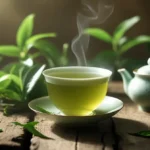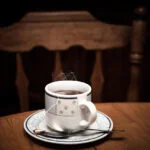Table of Contents
Wondering oolong tea what is it and why it matters? It’s the ancient Chinese secret that might be missing from your morning routine. Despite representing only 2% of the tea consumed worldwide, oolong tea offers a complex range of flavors from sweet and floral to rich and roasted.
As a traditional Chinese tea, oolong sits uniquely between green and black varieties, with oxidation levels varying from 10% to 90% depending on the specific type. Furthermore, oolong is especially popular in southeastern China and among ethnic Chinese communities throughout Southeast Asia. During my research, I discovered that an 8-ounce cup contains between 30 to 102 milligrams of caffeine, making it a perfect alternative to your regular morning brew. In fact, studies have shown that daily consumption of oolong tea can help remove free radicals and slightly decrease your chances of developing conditions like cancer, diabetes, and stroke.
In this guide, we’ll explore everything you need to know about oolong tea – from its rich history and production methods to its impressive health benefits and distinctive flavors. Whether you’re a tea enthusiast or simply looking to enhance your wellness routine, oolong tea might be exactly what you’ve been searching for.
What is Oolong Tea?
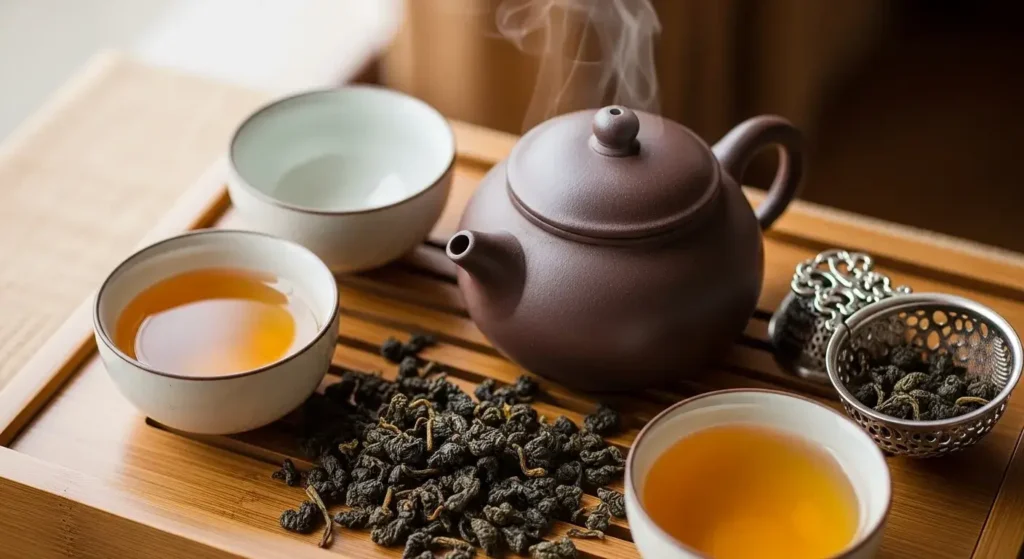
Oolong tea stands as one of the six main tea types in the world, occupying a unique middle ground in the tea spectrum. Let’s explore what makes this remarkable beverage so special.
Oolong definition and meaning
Oolong tea (pronounced “oo-long”) comes from the Chinese words “wū lóng,” which translates to “black dragon”. This poetic name likely refers to the dark, twisted appearance of the tea leaves after processing. Initially created in China, oolong is a traditional semi-oxidized tea made from the leaves of the Camellia sinensis plant.
The defining characteristic of all oolong teas is their partial oxidation process. After harvesting, the leaves undergo withering under strong sunlight, followed by careful oxidation before being curled and twisted. This artisanal process requires significant skill and precision, making oolong a true representation of tea-making craftsmanship.
How it compares to green and black tea
While green, black, and oolong teas all come from the same Camellia sinensis plant, the processing methods create their distinct differences:
- Oxidation levels: Green tea undergoes minimal oxidation, black tea is fully oxidized, whereas oolong sits between these extremes with oxidation levels ranging from 8% to 85%. This partial oxidation gives oolong its unique character.
- Flavor profile: Oolong shares some characteristics with both green and black teas. It offers light flavor notes but is often more complex than green tea, yet not as strong as black tea. The taste can vary from sweet and fruity with honey aromas to woody and thick with roasted notes.
- Processing: Green tea is heated quickly after harvesting to prevent oxidation. Black tea, conversely, is allowed to fully oxidize. Oolong follows a middle path – the leaves are bruised to start oxidation but this process is halted partway through by heating.
- Caffeine content: Oolong typically contains 37-55 mg of caffeine per 8oz serving, positioning it between green tea (35-45 mg) and black tea (40-70 mg).
What type of tea is oolong?
Oolong is a true tea (meaning it comes from the Camellia sinensis plant), but it represents a category unto itself. It’s neither a black tea nor a green tea but falls into its own classification based on its unique processing methods.
The most distinctive aspect of oolong is its wide range of possible expressions. Depending on the tea master’s expertise and intentions, an oolong might lean more toward green tea characteristics (if lightly oxidized) or black tea characteristics (if heavily oxidized). Additionally, oolongs are traditionally rolled, twisted, or curled into tight balls or thin strands, creating distinctive shapes that influence the final flavor.
Most authentic oolongs originate from China (particularly Fujian Province, including the Wuyi Mountains and Anxi County) and Taiwan. Taiwan’s oolongs are traditionally less oxidized (10% to 40%) and therefore tend to be greener in color with lighter flavors than their Chinese counterparts.
What truly sets oolong apart in the tea world is its remarkable versatility. Within this single category, you’ll find a spectrum of flavors from floral and fruity to grassy and woody. Consequently, oolong offers something for almost every palate, making it both accessible to beginners and fascinating for tea connoisseurs.
👉 Experience the ultimate oolong tea upgrade to your daily ritual today 👈
The Origins and History of Oolong

The story of oolong tea begins over a thousand years ago in the lush mountains of China’s Fujian province. This partially-oxidized treasure has a rich heritage that continues to fascinate tea enthusiasts worldwide.
Ancient Chinese roots
Oolong tea’s origins trace back to the Wuyi Mountain region in northern Fujian, one of China’s oldest tea-producing areas. Its earliest ancestor was likely Beiyuan tea, a compressed tea cake that became popular during the Song Dynasty (960-1279). These cakes, featuring dragon and phoenix designs, were highly prized as tribute teas for the imperial court.
Throughout the Ming Dynasty (1368-1644), a significant shift occurred when Emperor Zhu Yuanzhang issued a decree in 1391 to “abolish dragon cakes and switch to loose-leaf tea”. This royal proclamation transformed tea production methods, gradually moving from steamed tea cakes to loose-leaf varieties.
The actual development of modern oolong processing techniques appears to have evolved naturally. Records from the early Qing Dynasty (1650-1653) mention teas from Wuyi Mountain that would turn reddish or purplish after storage. Tea experts believe this phenomenon occurred because leaves were jostled in baskets during transport between mountains, causing partial oxidation along the edges – inadvertently creating the first semi-oxidized teas.
By the early 18th century (1708-1720), key processing steps like sun-withering, oxidation control, fixation, and roasting were documented in Wang Fuli’s tea text “Cha Shuo”. These techniques remain remarkably similar to those used in crafting Wuyi rock tea today.
Theories behind the name ‘oolong’
Several fascinating theories explain how oolong got its distinctive name. The most poetic explanation stems from its Chinese name “Wu Long” (黑龙), which translates to “Black Dragon”. This likely refers to the dark, long, curly appearance of the processed leaves, resembling the mythical Chinese dragon.
Another popular theory involves a tea farmer nicknamed “Black Dragon” (Wu Long) due to his dark sun-tanned skin from falling asleep while working on tea plantations. According to legend, this lazy fellow was harvesting tea when he spotted a hare. Distracted, he chased it for hours with his basket of tea leaves. When he eventually processed these accidentally bruised leaves, they produced an extraordinarily delicious brew. Supposedly, the technique of shaking tea in baskets to bruise the edges – now essential to oolong processing – came from this accidental discovery.
A third theory suggests oolong evolved from the name of its predecessor, Dragon-Phoenix Tea Cakes (Longfeng Tuan Cha). When loose-leaf tea replaced compressed cakes, the name supposedly changed to “Black Dragon” to maintain the association with its revered ancestor.
Oolong tea in Taiwan and beyond
Oolong tea journeyed across the Taiwan Strait in the late 18th century when Ke Chao brought tea plants from Fujian to Taiwan. Nevertheless, transaction records suggest tea trading in Taiwan’s Muzha area had already begun around that time.
A pivotal moment came in 1855 when Lin Fengchi brought Qingxin oolong plants from Fujian’s Wuyi Mountains to Taiwan’s Dongding Village (now Lugu, Nantou County) – establishing what would become famous as Tung-ting tea.
Following the 1860 Treaty of Tientsin, Scottish entrepreneur John Dodd recognized Taiwan’s tea potential. Working with local merchants, he began exporting “Formosa Oolong” in 1869, shipping 127 tons to the United States where it was enthusiastically received. This commercial success established tea as Taiwan’s primary export by the century’s end.
Over 300 years of development have resulted in dozens of high-quality oolong varieties in Taiwan, which now accounts for approximately 35% of global oolong production. From its ancient Chinese origins to its global presence today, oolong tea’s journey reflects centuries of craftsmanship, innovation, and cultural exchange.
Health Benefits of Oolong Tea
Beyond its fascinating history and unique processing methods, oolong tea offers an impressive array of health benefits backed by scientific research. Let’s explore what makes this semi-oxidized brew a potential wellness ally.
Antioxidant properties
Oolong tea contains powerful antioxidants, primarily polyphenols like epigallocatechin (EGC), epigallocatechin gallate (EGCG), and epicatechin-3-gallate (ECG). These compounds effectively scavenge harmful free radicals in the body. Remarkably, oolong tea steeped in 100°C water for 3 minutes demonstrates the strongest antioxidant activity. The catechins in oolong significantly contribute to its DPPH and superoxide radical scavenging abilities, with correlation values as high as r=0.9592.
Heart and brain health
Regular oolong consumption may significantly benefit cardiovascular health. Studies show that drinking more than 2.5 cups of oolong tea daily is associated with lower total cholesterol (3.22%), LDL cholesterol (6.69%), and triglyceride levels (11.99%). Moreover, men who consumed at least 8 ounces of oolong tea daily had a 61% lower risk of heart disease.
For brain health, oolong tea contains L-theanine, an amino acid that enhances alertness and reduces anxiety. Intriguingly, daily consumption of fermented teas like oolong is linked to a 13% lower prevalence of depressive symptoms in older adults. Studies also suggest that regular tea drinkers experience improved cognition, memory, and information processing speed.
Weight management support
Oolong tea appears to aid weight loss through several mechanisms. It increases fat oxidation and energy expenditure, with one study showing approximately 20% increased fat breakdown in participants who drank oolong tea compared to the control group. In a 6-week study involving overweight and obese subjects, 70% of severely obese participants lost more than 1kg, with 22% losing more than 3kg.
Improved digestion and gut health
The polyphenols in oolong tea positively impact gut microbiota. Over 90% of tea polyphenols reach the large intestine, where they feed beneficial microbes. Oolong tea has been shown to increase the growth of beneficial bacteria in the human intestine. Additionally, studies indicate oolong tea may help reduce inflammation and improve gut barrier function.
Skin and bone benefits
Oolong tea shows promising results for skin conditions like eczema. In one study, patients drinking oolong tea for a month experienced moderate improvements in their skin conditions, with 63% reporting benefits. For bone health, daily tea consumption over 10 years was associated with 2% higher overall bone mineral density. Oolong also contains fluoride, which helps strengthen tooth enamel and prevent cavities.
Is oolong tea good for you?
Based on scientific evidence, oolong tea offers numerous health benefits. Its unique combination of antioxidants may:
- Support heart health by reducing cholesterol and blood pressure
- Enhance cognitive function and potentially protect against neurodegenerative diseases
- Aid weight management through increased metabolism and fat oxidation
- Promote healthy digestion and gut microbiome
- Improve skin conditions and strengthen bones
With its moderate caffeine content (approximately 38mg per cup), oolong provides these benefits without excessive stimulation. As with most things, balance is key—drinking 1-2 cups daily appears to offer optimal benefits without side effects.
👉 Unlock the best oolong tea choice for a revolutionary wellness routine 👈
Understanding Oolong Tea Caffeine

For caffeine-conscious tea drinkers, understanding oolong’s stimulant content helps you make informed choices about your daily brew. Let’s explore this important aspect of oolong tea.
How much caffeine is in oolong tea?
Oolong contains a moderate amount of caffeine, typically ranging from 30 to 102 milligrams per 8-ounce cup. This variation occurs because caffeine levels depend on several factors. First, the specific variety matters—for instance, Da Hong Pao contains approximately 40-70mg per cup, whereas Tie Guan Yin typically has 30-50mg. Second, the oxidation level affects caffeine content—more oxidized oolongs generally contain more caffeine. Finally, brewing time significantly impacts stimulant levels—the longer you steep, the higher the caffeine content.
Notably, each subsequent steeping of the same leaves contains about one-third less caffeine than the previous infusion. This means your second or third cup from the same leaves will provide a gentler caffeine experience.
Caffeine comparison with other teas and coffee
Oolong occupies the middle ground in the caffeine spectrum of teas. An average 100ml serving contains approximately 16mg of caffeine, compared to 12mg in green tea and 42mg in coffee. Indeed, oolong typically delivers about one-quarter to one-third the caffeine of a similar serving of coffee.
Here’s how oolong compares to other popular beverages:
| Beverage (8 oz/240ml) | Caffeine Content |
|---|---|
| Coffee | 95-200 mg |
| Black Tea | 40-70 mg |
| Oolong Tea | 30-102 mg |
| Green Tea | 29 mg |
Does oolong tea help you stay alert?
Absolutely. Oolong tea provides a gentle yet effective alertness boost. The caffeine in oolong increases the release of norepinephrine and dopamine—brain messengers that enhance mood, attention, and brain function. Unlike coffee’s rapid caffeine spike, oolong releases caffeine more gradually.
What makes oolong truly special is its L-theanine content. This amino acid works synergistically with caffeine to promote relaxed alertness without the jitters coffee often causes. Studies show that beverages containing both caffeine and theanine increased alertness and attention within 1-2 hours after consumption.
For most adults, moderate oolong consumption (4-8 cups daily) stays well within safe caffeine limits while providing sustained mental clarity.
Types and Flavors of Oolong Tea

“Baozhong Oolong is like a timeless classic in literature; you discover something new every time you revisit it.” — Contemporary tea master (as cited by Path of Cha), Recognized tea master, expert in Taiwanese oolong traditions
The world of oolong offers an extraordinary spectrum of flavors and styles, with each variety telling its own story through aroma and taste.
Chinese oolong teas: Tieguanyin, Da Hong Pao
Tieguanyin (Iron Goddess of Mercy) represents one of China’s most beloved oolongs. This famed tea from Anxi County features a perfect balance of floral, vegetal, and slightly roasted notes with natural sweetness. Modern Taiwanese Tieguanyin tends to be more roasted than its Chinese counterpart, with a floral, fruity, and toasty profile.
Da Hong Pao (Big Red Robe) stands as royalty among oolongs from the Wuyi Mountains. As one of the most expensive teas worldwide, it displays complex earthy notes with hints of stone fruit, brown sugar, and molasses. Its robust character comes from heavy oxidation, creating a distinctive smoky taste with a velvety smooth body.
Taiwanese oolong teas: Milk Oolong, Baozhong
Milk Oolong (Jin Xuan) has gained popularity for its naturally creamy texture and taste. Although some sellers claim it’s steeped in milk, authentic versions derive their milky character solely from the tea varietal and processing. The flavor profile includes subtle hints of coconut, cinnamon and honeysuckle.
Baozhong (Pouchong) occupies the lightest end of the oolong spectrum, landing between green tea and traditional oolong. Grown exclusively in Taiwan’s Wenshan area, it offers a remarkably floral, refreshing taste.
Flavored and blended oolongs
Alongside traditional varieties, modern producers create flavored oolongs with peach, coconut, apple butter, and goji berry. Yet purists maintain that high-quality loose leaf oolong requires no additives—much like fine wine needs no flavoring.
What does oolong tea taste like?
Oolong’s flavor varies dramatically based on oxidation levels and processing methods. Light oolongs present floral, fruity notes with orchid aromas. Meanwhile, darker varieties develop toasty, nutty profiles with hints of chocolate and caramel.
The taste spectrum encompasses descriptions like buttery, milky, fruity, earthy, mineral, and woody. This remarkable diversity allows oolong to satisfy almost any palate preference—from those seeking delicate floral notes to others craving rich, complex flavors.
👉 Enjoy this premium oolong tea for a superior, calming daily escape 👈
Conclusion: Oolong Tea What Is It & Why It Matters
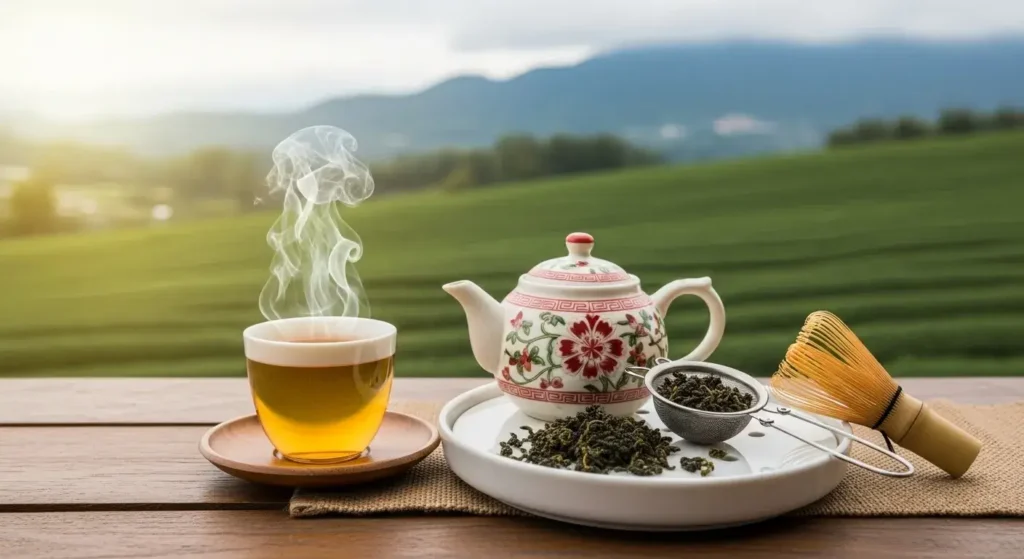
Oolong tea truly stands as a remarkable bridge between green and black teas, offering the best qualities of both worlds. Throughout history, this “Black Dragon” has evolved from ancient Chinese tea ceremonies into a globally appreciated beverage with countless variations. The wide range of flavors—from delicate floral notes to rich, toasted profiles—makes oolong exceptionally versatile for any palate or occasion.
Beyond its exquisite taste, oolong provides numerous health advantages. The powerful antioxidants fight free radicals while supporting heart health, cognitive function, weight management, and even skin conditions. Additionally, its moderate caffeine content delivers sustained alertness without the jitters commonly associated with coffee.
Chinese varieties like Tieguanyin and Da Hong Pao certainly offer traditional experiences, whereas Taiwanese options such as Milk Oolong and Baozhong present their own unique character. This diversity ensures everyone can find their perfect cup within the oolong family.
After discovering all these benefits and varieties, I encourage you to explore this ancient Chinese secret for yourself. Start your journey with a few different types to experience the remarkable spectrum oolong offers. Your morning routine might never be the same again. The next time you reach for your usual cup of coffee or tea, remember—an entire world of complex flavors and health benefits awaits in this partially-oxidized treasure that has captivated tea enthusiasts for centuries.
Key Takeaways
Discover why oolong tea deserves a place in your daily routine with these essential insights about this ancient Chinese treasure:
• Oolong is a unique semi-oxidized tea sitting between green and black varieties, with oxidation levels from 10-90% creating diverse flavor profiles from floral to roasted.
• Moderate caffeine content (30-102mg per cup) provides sustained alertness without coffee jitters, thanks to L-theanine that promotes relaxed focus.
• Powerful health benefits include antioxidant protection, heart health support, weight management aid, and improved cognitive function backed by scientific research.
• Wide variety of flavors available from Chinese classics like Tieguanyin and Da Hong Pao to Taiwanese specialties like Milk Oolong and Baozhong.
• Daily consumption of 1-2 cups can reduce cholesterol levels, support fat oxidation, and provide 61% lower heart disease risk in regular drinkers.
With over 1,000 years of refinement, oolong represents the perfect balance of tradition and wellness. Whether you’re seeking a coffee alternative or exploring new flavors, this “Black Dragon” tea offers something for every palate while delivering measurable health benefits that make it worth incorporating into your morning routine.
FAQs
Q1. How should I brew oolong tea for the best flavor? For optimal flavor, use one teaspoon of loose leaf oolong tea per cup. Heat water to about 195°F (90°C) and steep for 3 minutes. Avoid adding milk as it can mask the tea’s complex flavors.
Q2. Is it safe to drink oolong tea daily? Yes, drinking 1-2 cups of oolong tea daily is generally safe and can provide numerous health benefits. However, those with iron deficiency should consult a doctor, as oolong may interfere with iron absorption.
Q3. What makes oolong tea unique compared to other teas? Oolong tea is partially oxidized, placing it between green and black teas. This unique processing gives oolong its distinctive taste profile and potential health benefits, including improved metabolism and heart health support.
Q4. How does oolong tea’s caffeine content compare to coffee? Oolong tea contains about 30-102 mg of caffeine per 8-ounce cup, which is roughly one-quarter to one-third the amount in a similar serving of coffee. This provides a gentler, more sustained energy boost.
Q5. What are some popular types of oolong tea? Popular oolong varieties include Chinese teas like Tieguanyin and Da Hong Pao, and Taiwanese options such as Milk Oolong and Baozhong. Each offers unique flavors ranging from floral and fruity to rich and roasted.
👉 Taste this breakthrough oolong tea formula for an unforgettable flavor journey 👈



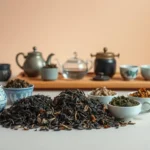

![Jasmine Tea vs Green Tea Benefits: Which Gives Better Health Results? [2025] jasmine tea vs green tea benefits](https://www.goteaworld.com/wp-content/uploads/2025/09/jasmine-tea-vs-green-tea-benefits-150x150.webp)
